Shipborne Acquisition, Tracking, and Pointing Experimental Verifications towards Satellite-to-Sea Laser Communication
Abstract
1. Introduction
2. Strategies for Establishing Optical Links
3. Method for Improving the Pointing Error
3.1. Pre-compensation for Ship Platform Attitude
3.2. Installation Error Model
3.3. Systematic Errors Model
3.4. Installation and Systematic Error Model Calculation and Application Process
4. Experiment and Results
5. Conclusions
Author Contributions
Funding
Acknowledgments
Conflicts of Interest
References
- Chan, V.W.S. Free-space optical communications. J. Light. Technol. 2007, 24, 4750–4762. [Google Scholar] [CrossRef]
- Das, S.; Henniger, H.; Epple, B.; Moore, C.I.; Rabinovich, W.; Sova, R.; Young, D. Requirements and challenges for tactical free-space Lasercomm. In Proceedings of the MILCOM 2008-2008 IEEE Military Communications Conference, San Diego, CA, USA, 16–19 November 2008; IEEE: Piscataway, NJ, USA, 2009. [Google Scholar]
- Kim, I.I. Wireless optical transmission of fast ethernet, FDDI, ATM, and ESCON protocol data using the Terra Link laser communication system. Opt. Eng. 1998, 37, 3143. [Google Scholar] [CrossRef]
- Kim, I.I. Comparison of laser beam propagation at 785 nm and 1550 nm in fog and haze for optical wireless communications. Proc. SPIE 2001, 4214, 26–37. [Google Scholar]
- Maynard, J.A.; Begley, D. Airborne laser communications: Past, present and future. Proc. SPIE Int. Soc. Opt. Eng. 2005, 5892. [Google Scholar] [CrossRef]
- Fletcher, T.M.; Cunningham, J.; Baber, D.; Wickholm, D.; Goode, T.; Gaughan, B.; Burgan, S.; Deck, A.; Young, D.W.; Juarez, J.; et al. Observations of atmospheric effects for FALCON laser communication system flight test. Proc. SPIE 2011, 8038, 80380F-1–80380F-12. [Google Scholar]
- Moll, F.; Horwath, J.; Shrestha, A.; Brechtelsbauer, M.; Fuchs, C.; Navajas, L.A.M.; Souto, A.M.L.; González, D.D. Demonstration of high-rate laser communications from a fast airborne platform. IEEE J. Sel. Areas Commun. 2015, 33, 1985–1995. [Google Scholar] [CrossRef]
- Guelman, M.; Kogan, A.; Kazarian, A.; Livne, A.; Orenstein, M.; Michalik, H. Acquisition and pointing control for inter-satellite laser communications. IEEE Trans. Aerosp. Electron. Syst. 2004, 40, 1239–1248. [Google Scholar] [CrossRef]
- Sodnik, Z.; Furch, B.; Lutz, H. Optical inter satellite communication. IEEE J. Sel. Top. Quantum Electron. 2010, 16, 1051–1057. [Google Scholar] [CrossRef]
- Toyoshima, M.; Takayama, Y.; Takahashi, T.; Suzuki, K.; Kimura, S.; Takizawa, K.; Kuri, T.; Klaus, W.; Toyoda, M.; Kunimori, H.; et al. Ground-to-satellite laser communication experiments. IEEE Aerosp. Electron. Syst. Mag. 2008, 23, 10–18. [Google Scholar] [CrossRef]
- Boroson, D.M.; Robinson, B.S. The lunar laser communication demonstration: NASA’s first step toward very high data rate support of science and exploration missions. Space Sci. Rev. 2014, 185, 115–128. [Google Scholar] [CrossRef]
- Robinson, B.S.; Boroson, D.M.; Burianek, D.A.; Murphy, D.V. The lunar laser communications demonstration. In Proceedings of the 2011 International Conference on Space Optical Systems and Applications (ICSOS), Santa Monica, CA, USA, 11–13 May 2011; IEEE: Piscataway, NJ, USA, 2011. [Google Scholar]
- Wang, J.; Lv, J.; Zhao, G.; Wang, G. Free-space laser communication system with rapid acquisition based on astronomical telescopes. Opt. Express 2015, 23, 20655–20667. [Google Scholar] [CrossRef] [PubMed]
- Wuchenich, D.M.R.; Mahrdt, C.; Sheard, B.S.; Francis, S.P.; Spero, R.E.; Miller, J.; Mow-Lowry, C.M.; Ward, R.L.; Klipstein, W.M.; Heinzel, G.; et al. Laser link acquisition demonstration for the GRACE Follow-On mission. Opt. Express 2014, 22, 11351–11366. [Google Scholar] [CrossRef] [PubMed]
- Yin, J.; Cao, Y.; Li, Y.H.; Liao, S.; Zhang, L.; Ren, J.; Cai, W.; Liu, W.; Li, B.; Dai, H.; et al. Satellite-based entanglement distribution over 1200 kilometers. Science 2017, 356, 1140–1144. [Google Scholar] [CrossRef] [PubMed]
- Liao, S.K.; Cai, W.Q.; Liu, W.Y.; Zhang, L.; Li, Y.; Ren, J.; Yin, J.; Shen, Q.; Cao, Y.; Li, Z.; et al. Satellite-to-ground quantum key distribution. Nature 2017, 549, 43–47. [Google Scholar] [CrossRef] [PubMed]
- Rabinovich, W.S.; Moore, C.I.; Mahon, R.; Goetz, P.G.; Burris, H.R.; Ferraro, M.S.; Murphy, J.L.; Thomas, L.M.; Gilbreath, G.C.; Vilcheck, M.; et al. Free-space optical communications research and demonstrations at the US Naval Research Laboratory. Appl. Opt. 2015, 54, F189–F200. [Google Scholar] [CrossRef] [PubMed]
- Gilbreath, G.C.; Rabinovich, W.S.; Moore, C.I.; Burris, H.R.; Mahon, R.; Grant, K.J.; Goetz, P.G.; Murphy, J.L.; Voelz, D.G.; Ricklin, J.C.; et al. Progress in laser propagation in a maritime environment at the Naval Research Laboratory. In Proceedings of the Free-Space Laser Communications V, SPIE Optics & Photonics 2005, San Diego, CA, USA, 31 July 2005; SPIE: Bellingham, WA, USA, 2005; Volume 5892, pp. 605–613. [Google Scholar]
- Wu, R.; Zhao, X.; Liu, Y.; Song, Y. Initial pointing technology of line of sight and its experimental testing in dynamic laser communication system. IEEE Photonics J. 2019, 11, 1–8. [Google Scholar] [CrossRef]
- Zhao, X.; Liu, Y.Q.; Song, Y. Line of sight pointing technology for laser communication system between aircrafts. Opt. Eng. 2017, 56, 126107. [Google Scholar] [CrossRef]
- Klein, M.B.; Sipman, R.H. Large aperture Stark modulated retroreflector at 10.8 microns. J. Appl. Phys. 1980, 51, 6101–6104. [Google Scholar] [CrossRef]
- Rabinovich, W.S.; Mahon, R.; Gilbreath, G.C.; Burris, R.; Goetz, P.G.; Moore, C.I.; Ferraro-Stell, M.; Witkowsky, J.L.; Swingen, L.; Oh, E.; et al. Free-space optical communication link at 1550 nm using multiple quantum well modulating retro-reflectors over a 1-kilometer range. In Proceedings of the Conference on Lasers and Electro-Optics, 2003, CLEO ’03, Baltimore, MD, USA, 6 June 2003; IEEE: Piscataway, NJ, USA, 2004. [Google Scholar]
- Rabinovich, W.S.; Goetz, P.G.; Mahon, R.; Swingen, L.A.; Murphy, J.L.; Ferraro, M.; Burris, H.R.; Moore, C.I.; Suite, M.R.; Gilbreath, G.C.; et al. 45-Mbit/s cat’s-eye modulating retroreflectors. Opt. Eng. 2007, 46, 104001. [Google Scholar] [CrossRef]
- Peter, G.G.; Mahon, R.; James, L.M.; Mike, S.F.; Michele, R.S.; Walter, R.S.; Ben, B.X.; Harris, R.B.; Christopher, I.M.; William, S.R.; et al. Modulating retro-reflector lasercom systems at the Naval Research Laboratory. In Proceedings of the Military Communications Conference, 2010-MILCOM, San Jose, CA, USA, 31 October–3 November 2010; IEEE: Piscataway, NJ, USA, 2010. [Google Scholar]
- Majumdar, A.K. Modulating retroreflector-based free-space optical (FSO) communications. In Advanced Free Space Optics (FSO); Springer: New York, NY, USA, 2015. [Google Scholar]
- Mutilba, U.; Kortaberria, G.; Egaña, F.; Yagüe-Fabra, J.A. 3D Measurement Simulation and Relative Pointing Error Verification of the Telescope Mount Assembly Subsystem for the Large Synoptic Survey Telescope. Sensors 2018, 18, 3023. [Google Scholar] [CrossRef]
- Huang, L.; Ma, W.; Huang, J. Modeling and calibration of pointing errors with alt-az telescope. New Astron. 2016, 47, 105–110. [Google Scholar] [CrossRef]
- Tiziani, D.; Garczarczyk, M.; Oakes, L.; Schwanke, U.; van Eldik, C. A Pointing Solution for the Medium Size Telescopes for the Cherenkov Telescope Array. AIP Conf. Proc. 2017. [Google Scholar] [CrossRef]
- Cheng, J. The Principles of Astronomical Telescope Design; Springer: New York, NY, USA, 2009. [Google Scholar]
- Donato, C.D.; Prouza, M.; Sanchez, F.; Santander, M.; Camin, D.; Garcia, B.; Grassi, V.; Grygar, J.; Hrabovský, M.; Řídký, J.; et al. Using stars to determine the absolute pointing of the fluorescence detector telescopes of the Pierre Auger Observatory. Astropart. Phys. 2007, 28, 216–231. [Google Scholar] [CrossRef]
- Luck, J. Mount Model Stability. In Proceedings of the 14th International Workshop on Laser Ranging Instrumentation, San Fernando, Spain, 7–11 June 2004. [Google Scholar]
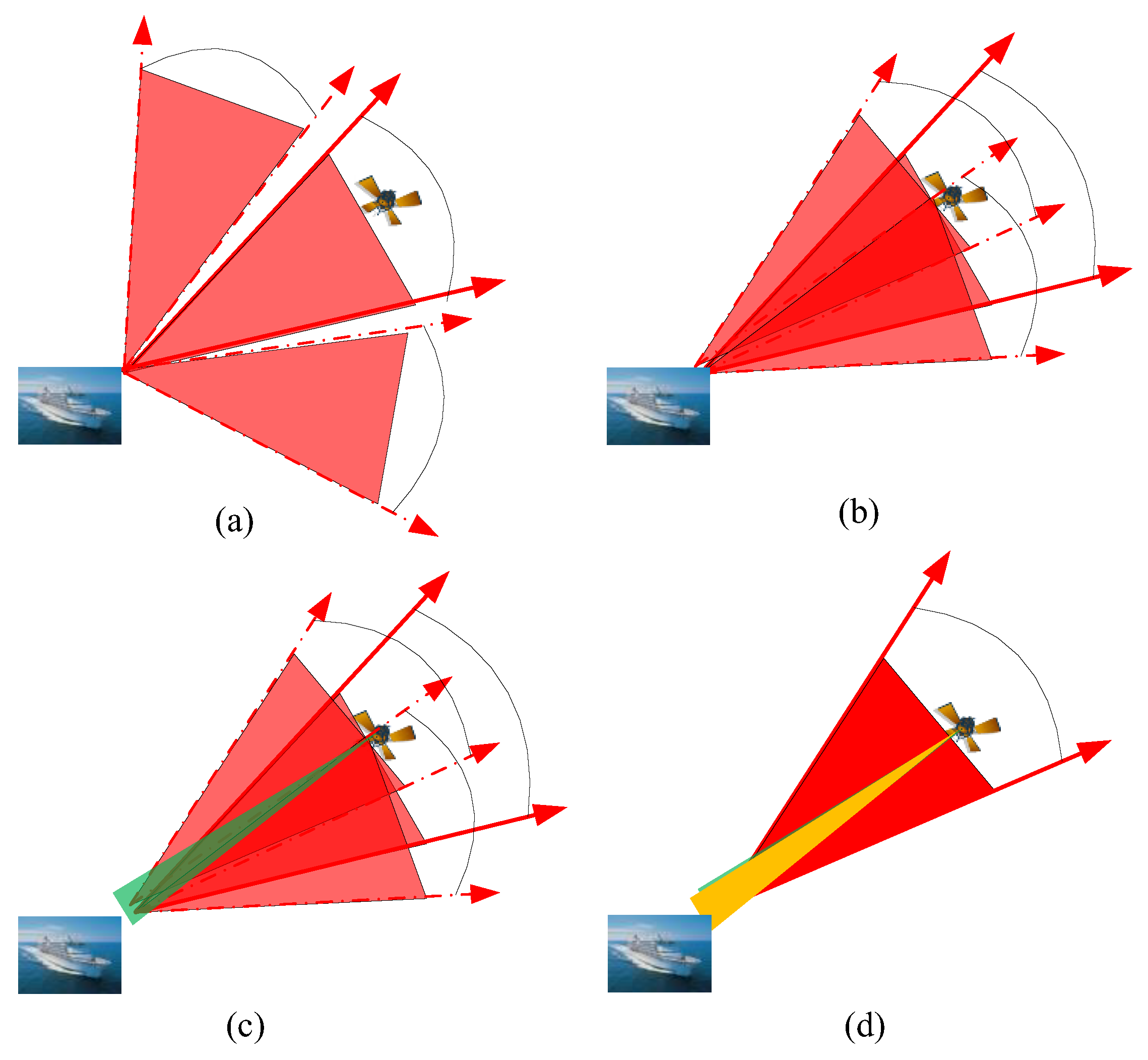

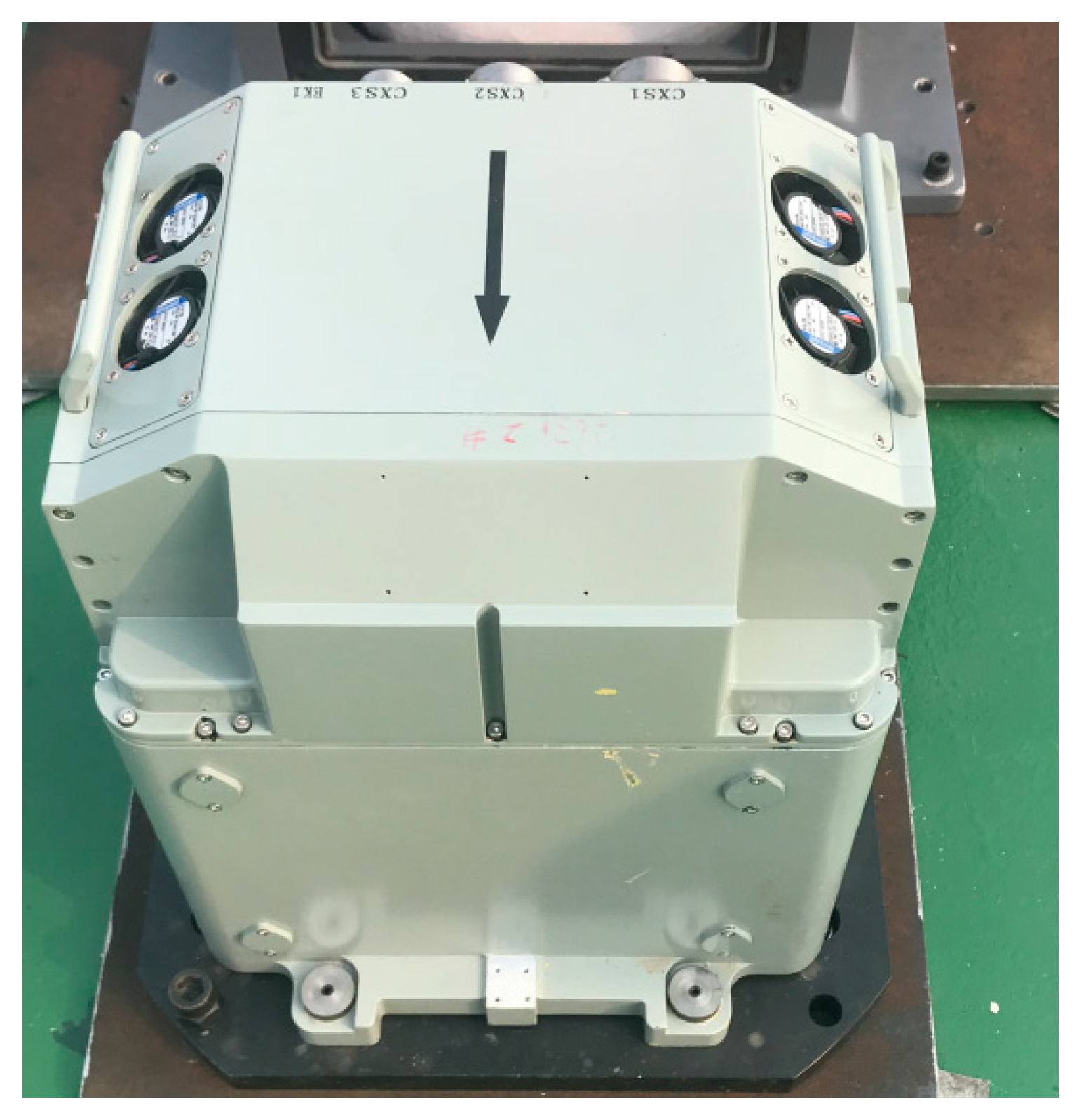
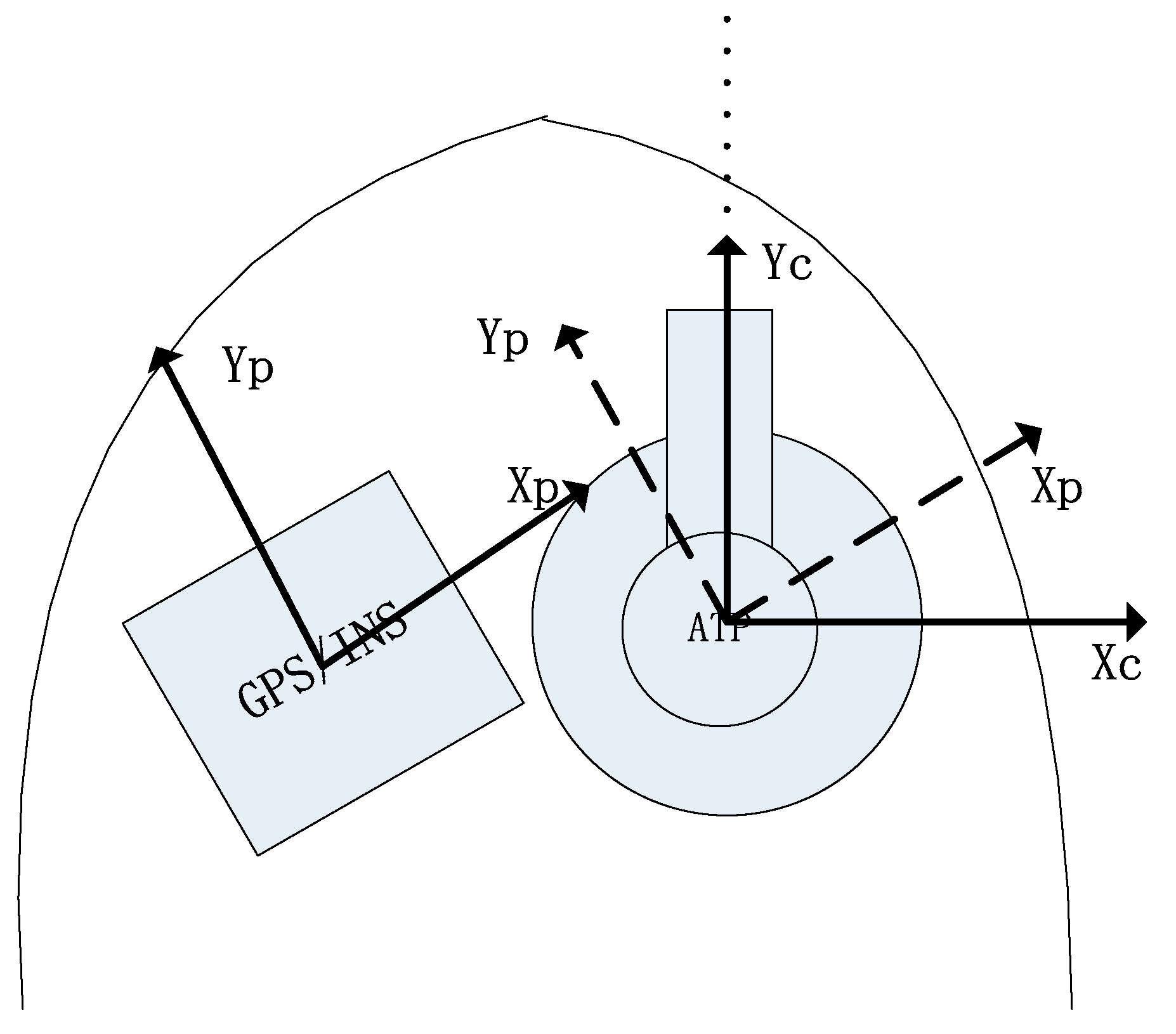
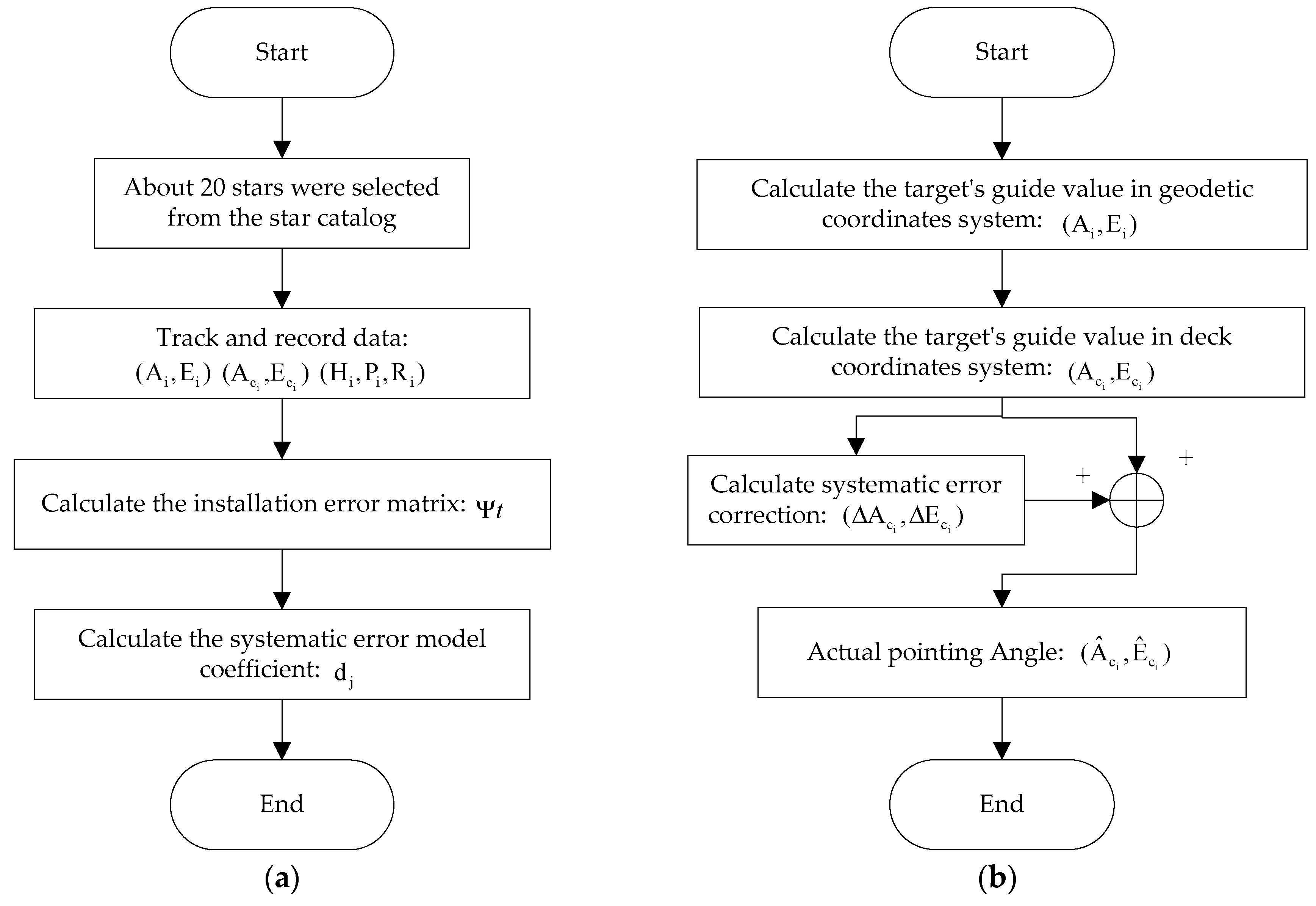
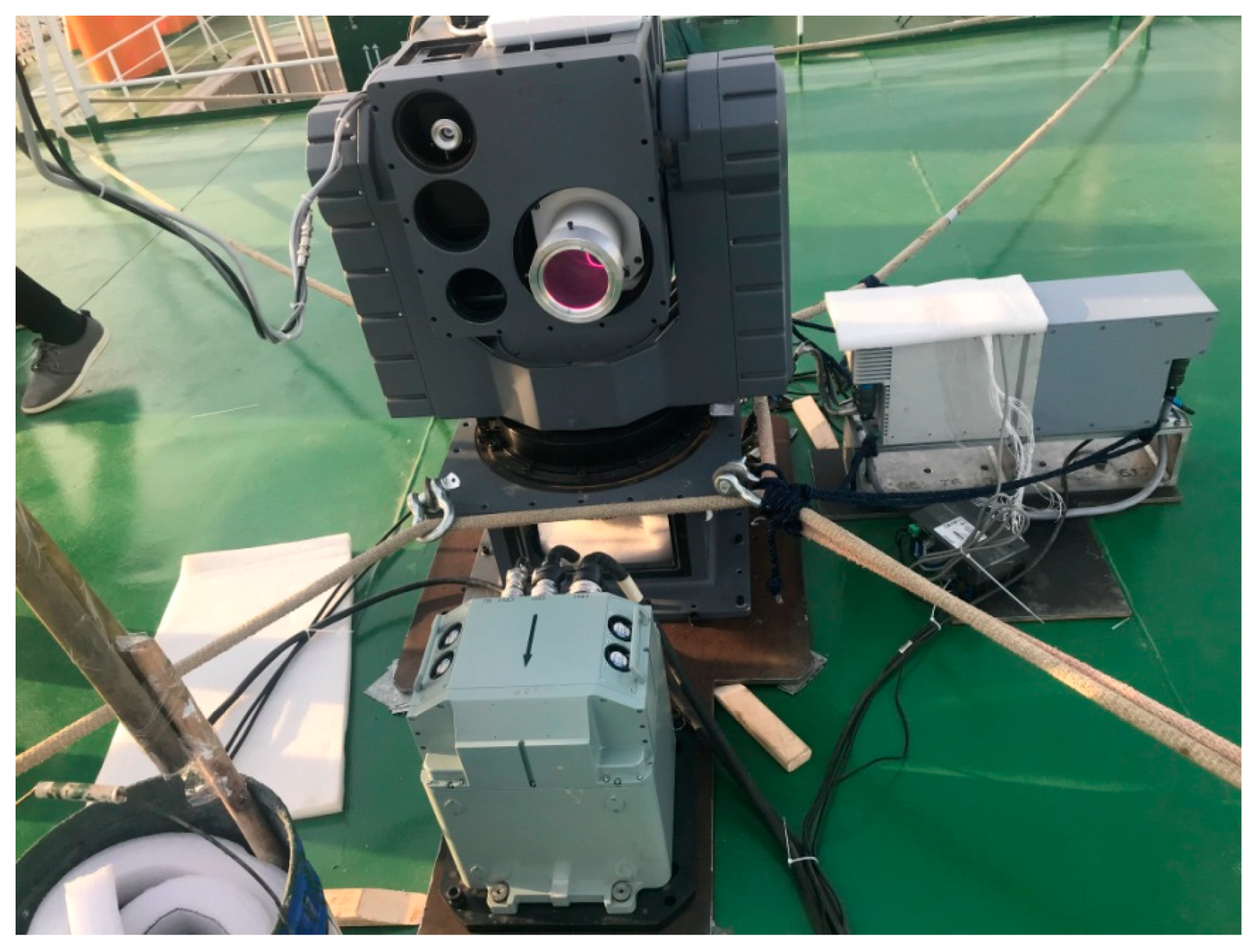
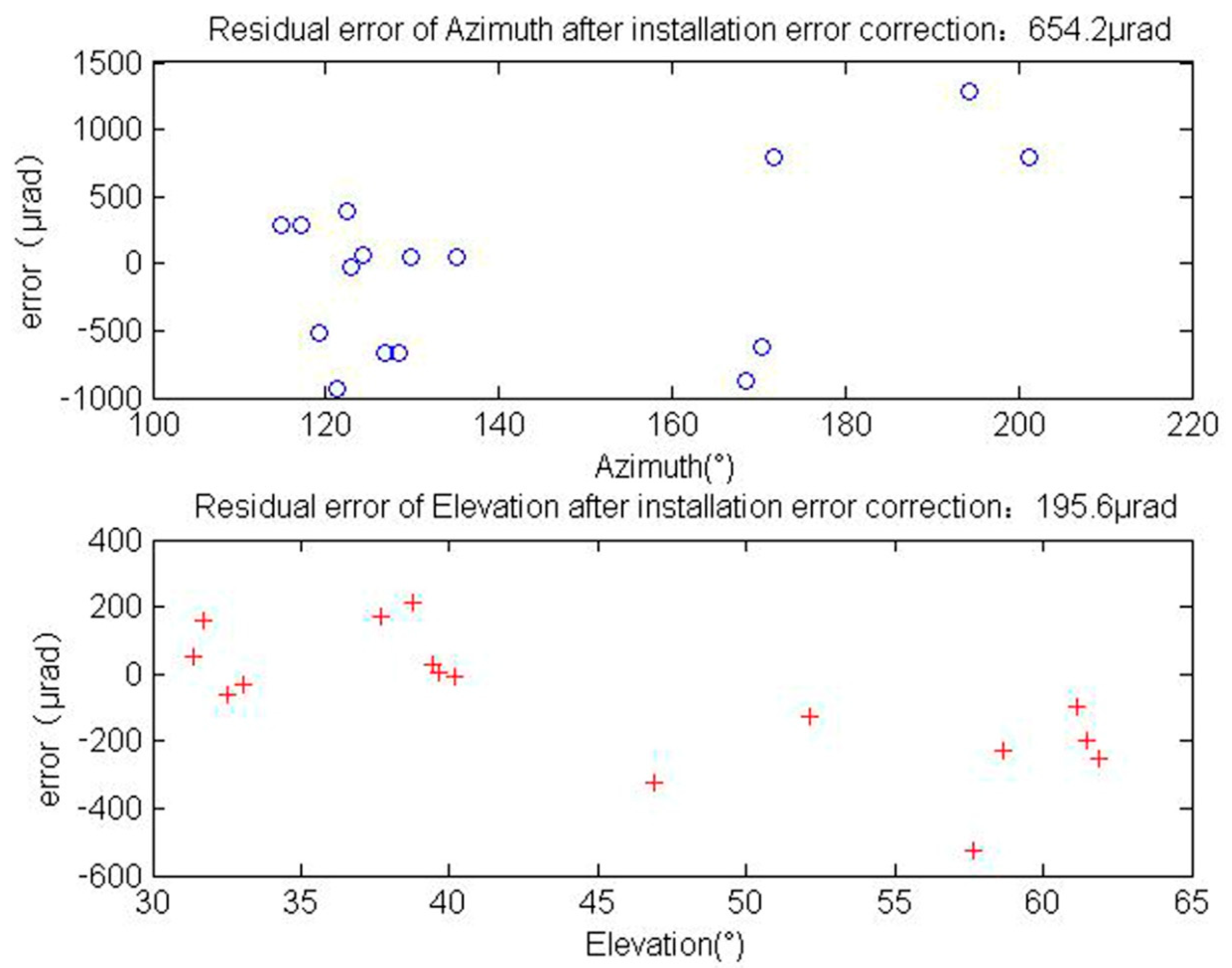
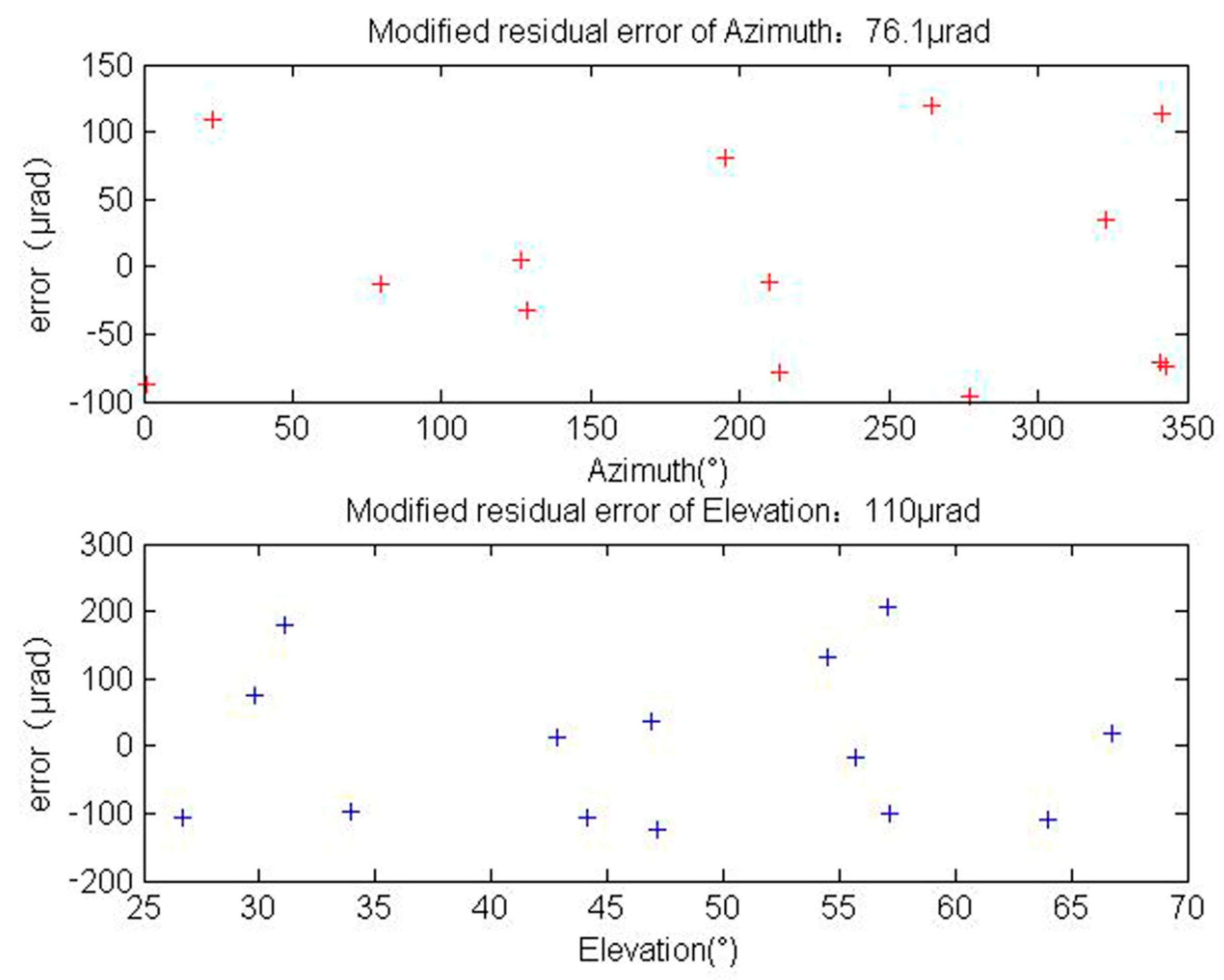
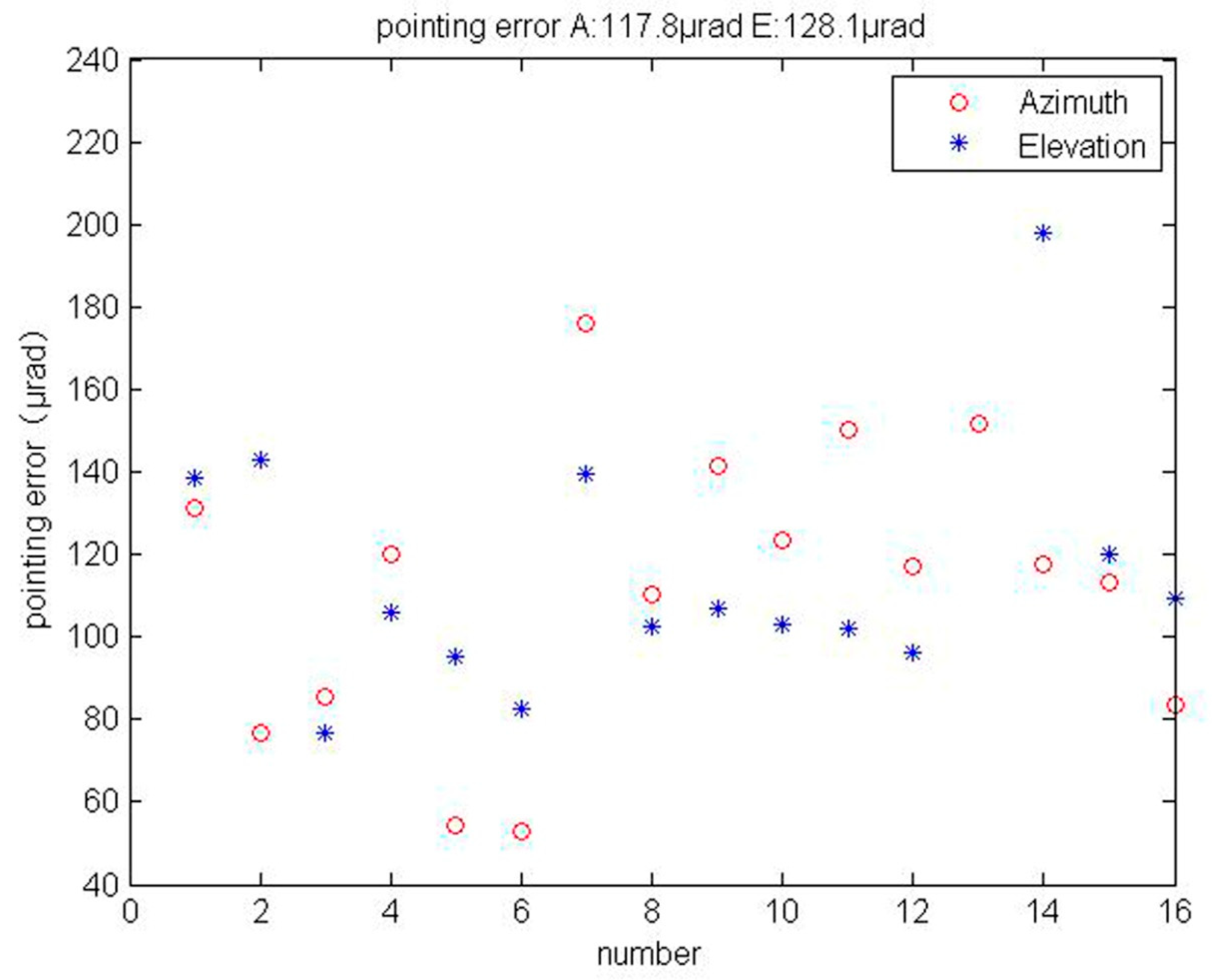
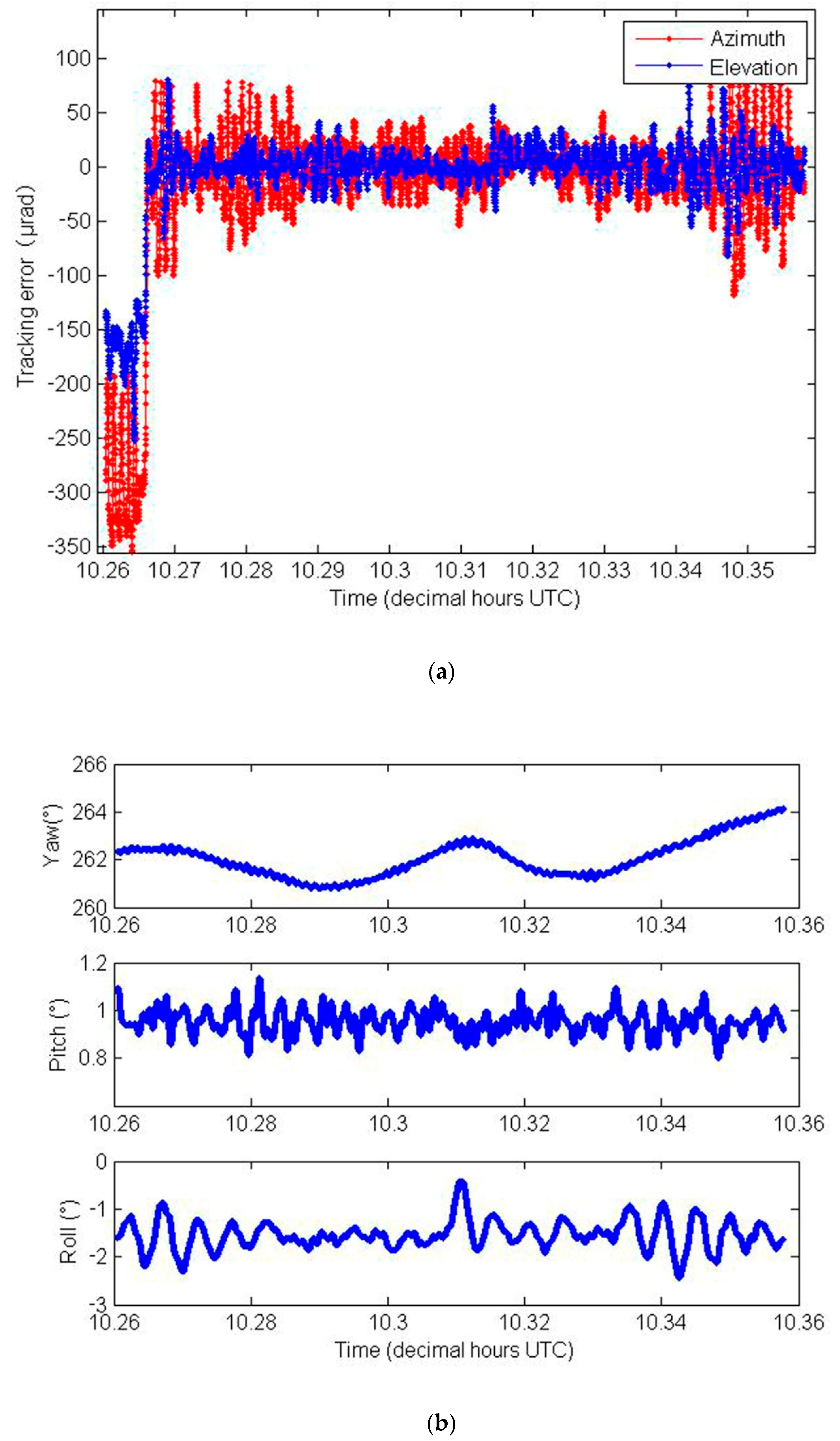
| Attitudeangle | Accuracy |
|---|---|
| Yaw | ≤0.18mrad (RMS) |
| Roll and pitch | ≤0.09mrad (RMS) |
| Term | Description | Azimuth Function | Elevation Function |
|---|---|---|---|
| 1. | Azimuth encoder offset | 1 | - |
| 2. | Elevation encoder offset | - | 1 |
| 3. | Azimuth axis tilt about fore-and-aft line | ||
| 4. | Azimuth axis tilt about axis Yc | ||
| 5. | optical axis misalign | - | |
| 6. | Non-orthogonality of Azimuth and Elevation axes | - | |
| 7. | Azimuth bearing ellipticity (sin) | - | |
| 8. | Azimuth bearing ellipticity (cos) | - | |
| 9. | Azimuth bearing ellipticity (sin) | - | |
| 10. | Azimuth bearing ellipticity (cos) | - | |
| 11. | Telescope tube flexure | - | |
| 12. | Azimuth encoder scale error | - | |
| 13. | Elevation encoder scale error | - | |
| 14. | Bi-periodic in azimuth | - | |
| 15. | Elevation encoder stiction | - | |
| 16. | Elevation bearing stiction | - |
© 2019 by the authors. Licensee MDPI, Basel, Switzerland. This article is an open access article distributed under the terms and conditions of the Creative Commons Attribution (CC BY) license (http://creativecommons.org/licenses/by/4.0/).
Share and Cite
He, D.; Wang, Q.; Liu, X.; Song, Z.; Zhou, J.; Wang, Z.; Gao, C.; Zhang, T.; Qi, X.; Tan, Y.; et al. Shipborne Acquisition, Tracking, and Pointing Experimental Verifications towards Satellite-to-Sea Laser Communication. Appl. Sci. 2019, 9, 3940. https://doi.org/10.3390/app9183940
He D, Wang Q, Liu X, Song Z, Zhou J, Wang Z, Gao C, Zhang T, Qi X, Tan Y, et al. Shipborne Acquisition, Tracking, and Pointing Experimental Verifications towards Satellite-to-Sea Laser Communication. Applied Sciences. 2019; 9(18):3940. https://doi.org/10.3390/app9183940
Chicago/Turabian StyleHe, Dong, Qiang Wang, Xiang Liu, Zhijun Song, Jianwei Zhou, Zhongke Wang, Chunyang Gao, Tong Zhang, Xiaoping Qi, Yi Tan, and et al. 2019. "Shipborne Acquisition, Tracking, and Pointing Experimental Verifications towards Satellite-to-Sea Laser Communication" Applied Sciences 9, no. 18: 3940. https://doi.org/10.3390/app9183940
APA StyleHe, D., Wang, Q., Liu, X., Song, Z., Zhou, J., Wang, Z., Gao, C., Zhang, T., Qi, X., Tan, Y., Ren, G., Qi, B., Ren, J., Cao, Y., & Huang, Y. (2019). Shipborne Acquisition, Tracking, and Pointing Experimental Verifications towards Satellite-to-Sea Laser Communication. Applied Sciences, 9(18), 3940. https://doi.org/10.3390/app9183940




